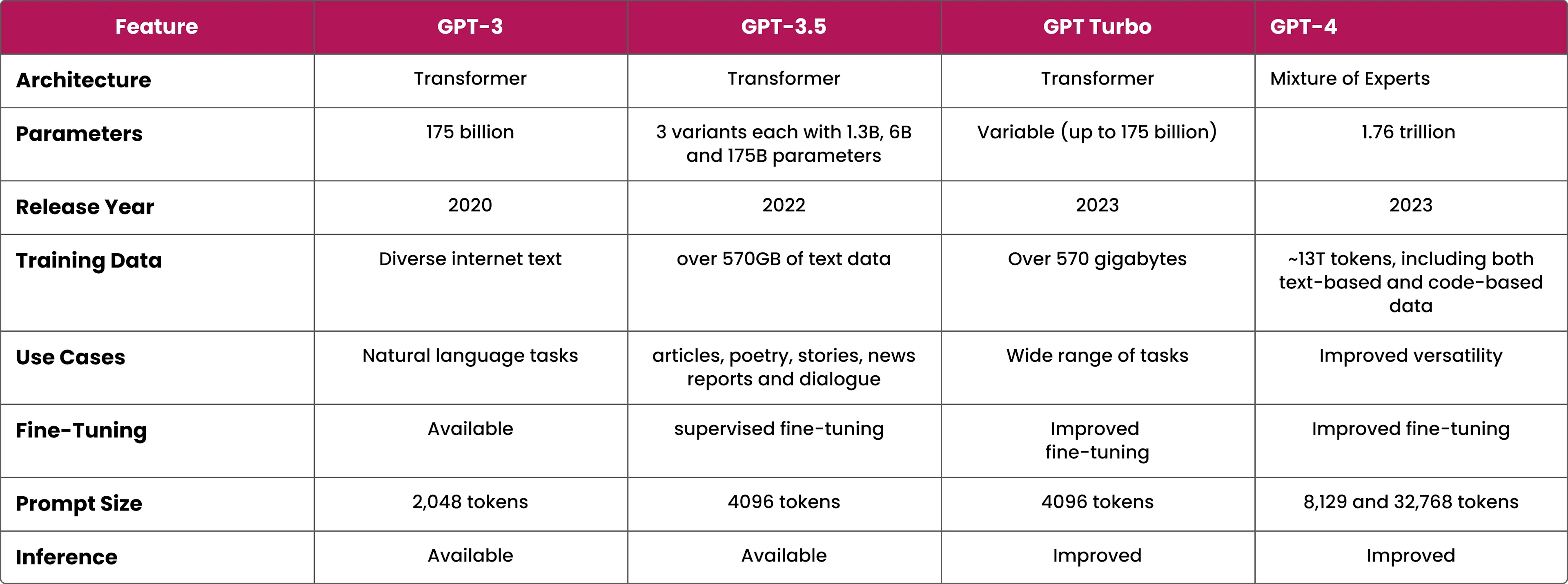
What are the differences between GPT, GPT3, GPT 3.5, GPT turbo GPT 4?
Over the years we have witnessed extraordinary advancements in the field of Artificial Intelligence, particularly with OpenAI advanced GPT models. These language models have completely transformed our interactions with AI.
Things are bound to become more fascinating, with the introduction of GPT 3.5 Turbo and GPT4. In this blog, we will explore the evolution from GPT to GPT 3.5 Turbo and beyond highlighting their differences, capabilities, and predictions for the future.
Comprehending GPT in Its Foundational Form
Before exploring OpenAI’s achievements, it is essential to grasp the core concept behind their creation – the original GPT (Generative Pre-trained Transformer). This avant-garde language model can generate contextually relevant text. While it could mimic human writing and produce its content, there were limitations in terms of understanding complex contexts and delivering high-quality responses.
How Can We Define GPT?
An Artificial Intelligence language model called GPT (short for “Generative Pre-trained Transformer”) was created by OpenAI. It is programmed to comprehend any information it is given and produce writing that is eerily similar to that produced by humans.
GPT was developed to meet the growing demand for intelligence systems that can understand and generate textual content. It offers a framework for applications, including content generation and chatbots. GPT utilises a transformer architecture enabling it to analyse sentences and comprehend the relationships between words. It then generates text based on learned patterns and contextual information from amounts of text data.
GPT-3.5 Turbo - The Evolution of the Vehicle
GPT 3.5 Turbo represents an upgraded version of GPT fine-tuned to enhance language comprehension and text generation capabilities. This advancement has significantly pushed the boundaries of AI capabilities. The increased text creation and context retention offered by GPT-3.5 Turbo make the software more flexible and applicable to a wider variety of applications, respectively. It operates based on the transformer architecture, as the GPT but benefits from training data allowing it to generate more accurate and contextually appropriate responses.
GPT vs. GPT-3.5 Turbo
The GPT 3.5 Turbo offers advancements compared to its version. This new version is more multifaceted demonstrating improved text generation skills and a deeper understanding of context. OpenAI achieved this by training the model on an amount of data resulting in more accurate and contextually relevant responses. Known for its versatility the GPT 3.5 Turbo is suitable for applications such as chatbots, content creation, and similar tasks.
One notable difference between the two versions lies in the enhanced language comprehension of GPT 3.5 Turbo. It provides responses while maintaining context during longer interactions and producing content that closely resembles human quality. It’s like having a conversation partner who possesses intelligence and eloquence.
Turbo GPT
The Turbo GPT is an enhancement to the GPT 3.5 Turbo that empowers developers to tune the model for activities or domains making it highly specialised. It belongs to the GPT family. By employing tuning techniques organisations and developers can customise intelligence solutions to suit their unique operational requirements resulting in enhanced functionality across a wider range of scenarios.
Turbo GPT utilises a technique called fine-tuning which involves training the model with domain data. This enables the model to grasp the intricacies and terminology associated with a subject thereby enhancing its performance in that area.
What is the difference between GPT-3.5 Turbo and Turbo GPT?
Although GPT 3.5 Turbo and Turbo GPT may appear similar, at a glance there are differences between the two in terms of their capabilities and applications. GPT 3.5 Turbo is an upgraded version of the GPT 3 model that OpenAI has refined to excel in understanding language and generating text across a wide range of uses. It represents an improvement over its predecessor in terms of language comprehension and text creation.
On the other hand, Turbo GPT is an extension of GPT 3.5 Turbo specifically designed for tuning purposes. It enables developers and organisations to customise the model for tasks or domains making it highly versatile. By allowing users to enhance the model’s performance in situations Turbo GPT expands on the adaptability already offered by GPT 3.5 Turbo making it an invaluable tool for tailoring AI systems to meet requirements.
In essence, GPT 3.5 Turbo serves as a versatile language model with language understanding and generation capabilities while Turbo GPT acts as a tool that empowers users to fine-tune GPT 3.5 Turbo for optimal performance, in targeted use cases thereby enhancing its ability to be customized and specialised.

What is the GPT-4?
OpenAI didn’t sit back. Relax after the performance of GPT 3.5 Turbo. They went ahead. Introduced GPT 4, a version that promises even more advancements. GPT 4 is designed to build upon the foundation laid by its predecessors offering improved language comprehension, context retention, and the quality of generated content. While the specific details may evolve the overall concept is expected to remain consistent.
The introduction of GPT 4 is anticipated to raise the bar for AI-driven applications opening up opportunities for innovation across all industries. GPT 4 will likely play a role in shaping the future of intelligence, be it in creating more lifelike virtual assistants, improving language translation capabilities, or revolutionising content creation.
Yes! OpenAI’s latest addition to the series of language models, known as GPT 4 is expected to set benchmarks for artificial intelligence in terms of natural language processing capabilities. GPT 4 is expected to bring advancements in language comprehension, contextual understanding, and the quality of text generation. This would open up possibilities in the field of AI applications.
Although many aspects of GPT 4s architecture are still being developed it is evident that it builds upon the foundation laid by its predecessors. It likely includes improvements in training data and algorithms resulting in enhanced performance.
A Comprehensive Comparison of OpenAI’s GPT models
All the OpenAI’s GPT models can understand and generate text and cost. However, the parameters, data, prompt sizes, etc., of GPT AI models differ. Below are representations in a tabular form.

OpenAI's Fine Tuning Initiative
The fine-tuning of GPT 3.5 Turbo is an advancement recently introduced by OpenAI. This model undergoes specialised training, in domains or activities allowing it to perform better in environments. This means you can now customise GPT 3.5 Turbo to excel in fields, such as medicine or law by familiarising it with the complexities and terminology of those professions. It can also be tailored for excellence in types of text generation.
The process of fine-tuning empowers software developers and companies to create AI solutions that are highly relevant to their industries. Consequently, fine-tuning serves as a tool for customization and specialisation. In short, OpenAI has not implemented fine-tuning for Turbo GPT 3.5. Has also extended it to GPT 4. This allows AI applications to be customised and adaptable in ways. Developers now have the ability to design AI models that excel in tasks, industries, and sectors.
The Future Holds an Infinite Variety of Possibilities
As we envision the future we can see that AI holds promise with models like Turbo GPT 3.5, Turbo GPT, and GPT 4 leading the way. These technological advancements are opening up alternatives across various business sectors such, as healthcare, finance, creative content development, and customer service.
There are possibilities. As each new version emerges, artificial intelligence will play an increasingly significant role in our daily lives. In summary, OpenAI’s relentless pursuit of AI excellence has paved the way for advancements in language modeling. These models represent a journey of innovation that is reshaping the field of intelligence.
Starting with the GPT. Progressing to the adaptable GPT 3.5 Turbo, as the specialised Turbo GPT and the forward-thinking GPT 4 these models span from the past to the future. We stand at the brink of an era where AI will continue to progress offering us answers and opportunities that were once fantasies.
Conclusion
We have seen differences between the previous versions of OpenAI’s GPT models and the current versions. While GPT Turbo improves fine-tuning and inference, GPT-3 outshines with its 175 billion parameters. Without a doubt, GPT-4 brings advancements in text generation and language comprehension and Codiste has leveraged GPT technology to revolutionise industries, including content creation and customer support.
Their innovative implementations showcase the capabilities of GPT in enhancing productivity and user satisfaction, solidifying Codiste’s position as an AI development company leading the way in AI-powered solutions. Hiring an AI consultant from Codiste helps explore novel use cases for your projects. They also help you to find and discover new prospects and promote digital transformation.



A Deep Dive into How Agentic RAG Automat...
Know more
Is Agentic RAG Worth the Investment? Age...
Know more
What is an AI Voice Agent for Customer C...
Know more
